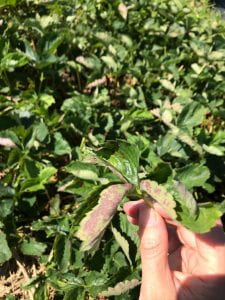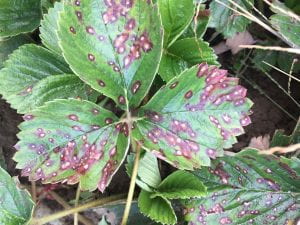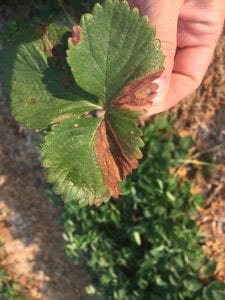by Esther Kibbe, WNY Berry Specialist with Harvest NY
It is easy to overlook your strawberries this time of year, with the focus on fall crops, but there are some critical activities that will set you up for a successful crop next spring. As days shorten, and temperatures cool, the plants are creating the flower buds for spring, and storing up energy for winter survival. Fertility, disease management and weed control are important right now to help strawberries transition to winter and be ready for spring.
Fertilize: If you haven’t already, it is time, and getting late, to apply nitrogen. Ideally, N rates should be based on leaf analysis (the lab report will give recommended rates) but if you didn’t get a leaf sample done, 30-50 lb of actual N per acre is appropriate for most fields. Phosphorous (P) is usually adequate in most WNY fields, especially if manure has been used in the past. If you don’t have a fertilizer on hand, common lawn fertilizer blends of 26-0-3 or 29-0-4 (or similar) are cheap and readily available products. Remember that the ‘numbers’ on a fertilizer label are percentages, so you would need about 170 lb/acre of a 29-0-4 to apply 50 lb/ac of actual nitrogen (50/.29 = 172). Just be sure to avoid “weed and feed” products, as the included herbicide might not be labeled or compatible with strawberries. Note that fall nitrogen is only appropriate for strawberries – raspberries and blueberries should only have N applied in the spring.

Diseases: Some strawberry fields are showing serious powdery mildew and leaf spot issues. These reduce the plant’s ability to store energy and can negatively impact winter survival. Infections now will also contribute to disease developing in the spring, when it will be more difficult to manage.
Powdery mildew causes leaves to curl upwards or show whitish spots. Even more obvious are the other foliar diseases: Leaf Spot, Leaf Scorch and Leaf Blight.

Leaf Spot causes purplish lesions with brownish or gray centers.
Leaf Scorch lesions look very similar, except that the centers stay purple, and can eventually cover the whole leaf. Leaf Blight lesions look similar early on, but will grow to form a dry brown v-shaped lesion. Each has a slightly different set of approved fungicides, with some overlap – be sure to check the

labels or the Cornell Guidelines. Before autumn rains saturate the soil, September and October are a good time to apply Ridomil Gold or Phostrol to reduce Red Stele and Phytophthora root rots.
Weeds: Fall is a critical time to manage weeds in strawberries. Hand weed or cultivate to reduce perennial weeds going into winter. Preemergent herbicides such as Dacthal, Devrinol and Sinbar can be applied in the fall before you cover with straw mulch or fleece. 2-4,D and Stinger may be used for specific weed issues. Be sure you know the types of weeds in your field – some may require a particular herbicide for successful control.
If you’d like a farm visit to help with disease, pest or weed identification, I am available to help all berry growers across WNY. Call 607-351-1991 to schedule a visit, or if you have any berry-related questions.
